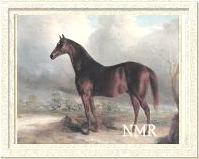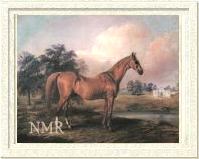|
|
Galopade

|
|
Galopade was one of the most important mares ever imported into the U.S. She had three exceptional daughters -- Fandango (1836), Cotillion (1837), and Reel (1838), who were the foundation of what is sometimes called the "Dance" family, for obvious reasons. The branch of Family 23 springing from Galopade in America produced such horses as the legendary Domino, who was inbred three times to it, leading sire Hamburg, and U.S. Triple Crown winner Affirmed. It is still going strong, producing such champions as the Canadian champ, Chris Evert, and Winning Colors, one of the few mares to win the Kentucky Derby.
Galopade was bred in England by a North country turfite, Colonel King, of Ashby, Lincolnshire, and foaled in 1828. Her dam, Camillina, by Camillus, was a fair race mare who ran in top company during her only season at age 3. She won three and placed second twice in her six races, her wins including the 2 mile Champion Stakes at Lincoln; the only race in which she ran unplaced was the Doncaster St. Leger which was won by Memnon that year. Her sire, Catton, ran for six successive years in the north of England in the colors of his breeder, the Earl of Scarsborough. He won a number of races, and seldom failed to place; his wins included the Doncaster stakes three years in a row, the York Gold Cup twice, and the Great Subscription Purse at York three successive times. |
|
|
Catton was a popular north country stallion after he retired as a public stallion at various locations around Yorkshire, and his offspring included Derby winner Mundig, Royal Oak, and Trustee, the latter imported into the U.S. and subsequently an influential sire who got top racehorses Revenue and Peytona, among others.
Galopade ran twice as a two year old, her only season. She ran second in a sweepstakes at Beverley, and she won a sweepstakes over a mile at Lincoln. She was imported around 1833 - 34, apparently into Canada, and was bred to American Eclipse in 1834, but did not catch. That year or early in 1835, she was purchased by Irish-born James Jackson of Alabama, one of the most influential of all early American breeders, who had successful businesses in Nashville and New Orleans, but whose stud farm, called Forks of the Cypress,was in Alabama .
|

Leviathan sired two top fillies on Galopade. Image used with permission from the National Museum of Racing.

Glencoe got Reel. Image used with permission from the National Museum of Racing.

Her daughter Reel. Image used with permission from the National Museum of Racing.
| |
Jackson imported and stood at stud Leviathan, who became the leading sire in America five times. Leviathan, though owned by Jackson, stood in Tennessee. He also imported Glencoe, purchased for him through the agency of Richard Tattersall, and sent to the U.S. in June of 1836, after standing that spring in England, during which time he got the great mare Pocahontas. In the U.S., Glencoe was a "filly-getter," his daughters proving superior on the race track and in the breeding shed; he was eight times leading sire in the U.S. Glencoe stood at Forks of the Cypressuntil Jackson's death.
After Galopade was purchased by Jackson, she was sent to Tennesse to be bred to Leviathan, and she produced both Fandango (1836) and Cotillion (1837) to him. She was sent to Forks of the Cypress, thereafter, where she was bred to Glencoe every year until her death.
Her first foal by Glencoe was Reel, 1838, followed by the grey filly Cracovienne, 1839, Waltz, a colt of 1840, Jig, a colt of 1842 who was gelded, an 1844 filly named Quadrille, and Hornpipe, a colt of 1846, her last recorded foal. Of the latter Glencoe foals, only Cracovienne was useful.
Fandango, Galopade's first foal, by Leviathan, produced some good runners, such as Rigadoon, and Grizette, who produced winners, and who bred on through her daughter, Geneva. She also produced, in 1843, Judith, by Glencoe, who was fourth dam of Mannie Gray, later celebrated as the dam of the good race filly Correction and the unbeaten two-year-old, Domino. It is through Mannie Gray's daughters that the Fandango line continues to the present. Champion racehorses from this line include Zev, who won two legs of the U.S. Triple Crown; the good racehorse and leading sire Hamburg; Triple Crown winner Affirmed; the broodmare and race filly Twilight Tear; Hollywood Gold Cup winner Criminal Type.
|
From Cotillion, who was a good racer, came Dance, by Glencoe, and Gallopade Jr., also by Glencoe, both of whom produced winners and bred on through their daughters. Some of the good racehorses from these mares were the top racing filly by Glenelg, Los Angeles; the terrific staying mare Heel-and-Toe; the good mare Mercedes, who produced three outstanding runners, including Runnymede, Travers Stakes winner Barnes, and The Futurity and Gazelle Handicap winner The Butterflies. The champion Canadian filly Dance Smartly was from the Cotillion branch; so was Discovery, a top U.S. broodmare sire.
Galopade's daughter Reel, by Glencoe, ranks as one of the most important American matrons of the nineteenth century. She got ten top class racehorses from thirteen foals, and an influential sire in her son War Dance. It is through her daughter, Fanny Wells, that this branch descends. It includes the champion fillies Two Lea, Chris Evert, and Winning Colors; Chief's Crown, winner of the Breeders' Cup Juvenile, and a number of other top racehorses.
--Patricia Erigero
|
|
|
|

